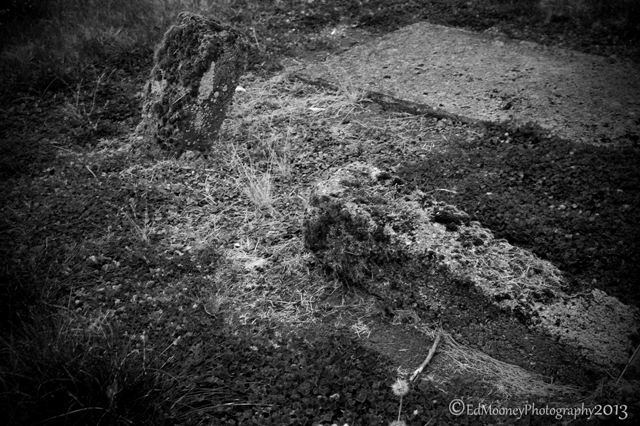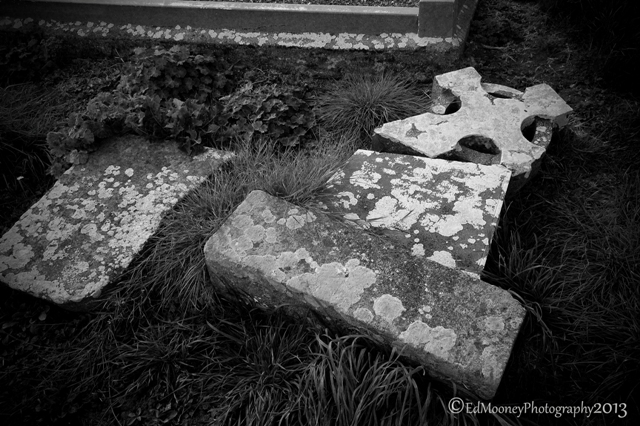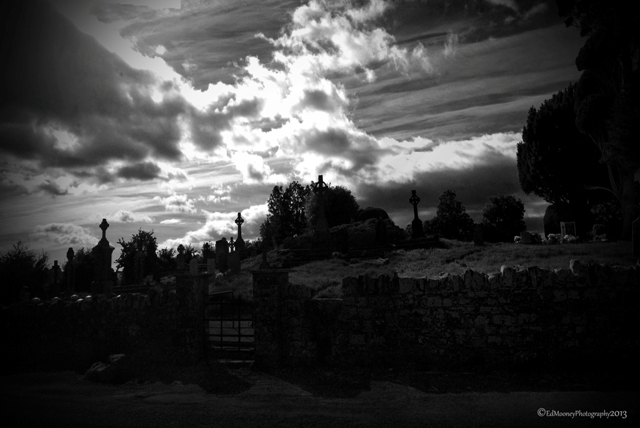The Ruins at Grallagh were yet another site that I came across by pure chance. Initially it looked like just another old graveyard, but I decided to stop off for a closer look and I am sure glad that I did. Although I found it on the side of a typical country road in what looks like the back end of nowhere, it is actually located within the Fingal area of Dublin. This site turned out to be both a great find with a crumbling ruin of an old church, a holy well and a holy stone all in the one location. But it was also a nightmare to research. There really is very little to find in relation to this site, so apologies for the lack of history in this post.
Perched atop a small hill in the center of the graveyard are the remains of what I can only assume was an early Christian church. What is left of it is a partially crumbling wall and fragments of some foundations. As mentioned I could not even find a date for this church let alone any history associated with the ruin. The graveyard itself contains many grave markers which date from the 1700’s to the present day which would suggest that it is still somewhat in use. The majority of older graves are situated in the south of the graveyard and consist of various cut stone grave markers.
Moving on you will come across a rather unique structure also within the confines of the walled graveyard to the south of the church.This holy well a natural spring, it is accessed via stone steps which would lead me to believe that it may have once been used as an emersion well and may actually predate the arrival of Christianity. On my travels I have come across a number of these which were actually sacred springs used in ritual by the Druids of ancient Ireland. As part of the conversion to Christianity many of these popular sites were taken over by the church and given an association to a particular saint. In this instance depending on where you read or who you talk to, this well was connected to a St. Michael or St. MacCuillin or a St. Meccallin. Chances are all these are variations of the same name.There was a St. McCuillin whom founded nearby Lusk. Perhaps this is the Saint after which it is known as. The Spring/Well is now enclosed in a small well house which looks like a miniature early Christian chapel. The walls are made from cut limestone as is the double pitched roof. Traditionally these sacred waters were believed to have been a cure for the whooping cough. Sadly these waters have since dried up, perhaps as a result of the local agriculture affecting the water table.
Just outside the entrance to the graveyard there is an unusually shaped boulder, believed to be a holy stone. Again known as the Mark of St. Michael or the Grallagh Holy stone, it has a hole running through its center. It is said that if you lie on your back and put your hand through the hole, this will cure any backache which you may have. So the next time I do my back in, im going to give this a try. 🙂
For more of my images, why not visit my Website,or follow me on Facebook, Instagram or Twitter.

















Interesting photos and reading. Thanks for sharing.
Irene
LikeLike
Incredible series of shots…. Your work brings me back into the mystic of the Celtic lands, a real delight. Use of B&W really adds to the mood as well. Cheers!
LikeLike
Nice find – always glad when i take a chance and it pays off.
LikeLike
🙂
LikeLike
Thanks for sharing your great find…great photos too.
LikeLike
Thank you 🙂
LikeLike
I love the moody B&W photos and seeing the Celtic crosses in their setting. Really interesting. Thanks for a great article. ~SueBee
LikeLike
My pleasure, glad that you liked it, 🙂
LikeLike
Fascinating, and I agree it’s great finding a new place with more toitthan you at first thought! 🙂
LikeLike
These graveyard shots are so eerie and dramatic; instantly made me think of the very creepy opening to Dickens’ Great Expectations – the churchyard on the marsh whence the escaped convict Magwich pounces on Pip.
LikeLike
Thanks Tish, I see what you mean, I haven’t watched that movie in years, must get it for the Crimbo 🙂
LikeLike
Amazing pictures!
LikeLike
Thanks Noah
LikeLike
Love that first image.
LikeLike
it must be so amazing to live in a place where you can stumble upon such rich history, places with such presence because of generations passing through. the cloud formations you captured are amazing! they accent the architecture and shapes beautifully, and create a sense of mystery and wonder.
LikeLike
All of your photos are hauntingly beautiful – this series touched me – you make history relevant and personal and let us all feel like we’re right there with you viewing a bit of history and invoking the spirit of the time they were made – keeping it alive today. I love your photos – don’t ever stop hunting!
LikeLike
Thanks you, the support that I have been getting this past year is unbelievable and very much appreciated. And the good news is, there will be even more next year 🙂
LikeLike
Ed, the photos are amazing … for some reason that one of the stairs in the springwell (I hope I got that right). You find the most amazing ruins! Happy Holidays to you and your family!!
LikeLike